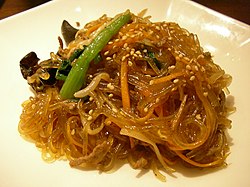 Japchae , a Korean dish of stir-fried cellophane noodles | |
| Type | Noodle |
|---|---|
| Place of origin | Korea |
| Korean name | |
| Hangul | 국수 |
| RR | guksu |
| MR | kuksu |
| Alternate name | |
| Hangul | 면 |
| Hanja | 麵 |
| RR | myeon |
| MR | myŏn |
| This article is part of a series on |
| Korean cuisine 한국 요리 조선 료리 |
|---|
 |
Korean noodles are noodles or noodle dishes in Korean cuisine, and are collectively referred to as guksu in native Korean or myeon in hanja character[ clarification needed ]. The earliest noodles in Asia originate from China, and date back 4,000 years ago. [1] In Korea, traditional noodle dishes are onmyeon (beef broth-based noodle soup), called guksu jangguk (noodles with a hot clear broth), naengmyeon (cold buckwheat noodles), bibim guksu (cold noodle dish mixed with vegetables), kalguksu (knife-cut noodles), kongguksu (noodles with a cold soybean broth) among others. In royal court, baekmyeon (literally "white noodles") consisting of buckwheat noodles and pheasant broth, was regarded as the top quality noodle dish. Naengmyeon, with a cold soup mixed with dongchimi (watery radish kimchi) and beef brisk broth, was eaten in court during summer. [2]



